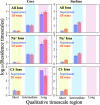The molecular picture of the local environment in a stable model coacervate
- PMID: 39349768
- PMCID: PMC11442467
- DOI: 10.1038/s42004-024-01304-1
The molecular picture of the local environment in a stable model coacervate
Abstract
Complex coacervates play essential roles in various biological processes and applications. Although substantial progress has been made in understanding the molecular interactions driving complex coacervation, the mechanisms stabilizing coacervates against coalescence remain experimentally challenging and not fully elucidated. We recently showed that polydiallyldimethylammonium chloride (PDDA) and adenosine triphosphate (ATP) coacervates stabilize upon their transfer to deionized (DI) water. Here, we perform molecular dynamics simulations of PDDA-ATP coacervates in supernatant and DI water, to understand the ion dynamics and structure within stable coacervates. We found that transferring the coacervates to DI water results in an immediate ejection of a significant fraction of small ions (Na+ and Cl-) from the surface of the coacervates to DI water. We also observed a notable reduction in the mobility of these counterions in coacervates when in DI water, both in the cluster-forming and slab simulations, together with a lowered displacement of PDDA and ATP. These results suggest that the initial ejection of the ions from the coacervates in DI water may induce an interfacial skin layer formation, inhibiting further mobility of ions in the skin layer.
© 2024. The Author(s).
Conflict of interest statement
The authors declare no competing interests.
Figures





Similar articles
-
Interfacial properties of polymeric complex coacervates from simulation and theory.J Chem Phys. 2018 Oct 28;149(16):163315. doi: 10.1063/1.5029934. J Chem Phys. 2018. PMID: 30384702
-
Study of the Interactions between Simple Coacervates and Chemicals for Water Depollution by Self-coacervation.Langmuir. 2024 Nov 26;40(47):24854-24862. doi: 10.1021/acs.langmuir.4c02738. Epub 2024 Oct 17. Langmuir. 2024. PMID: 39418541
-
Multiphasic Coacervates Assembled by Hydrogen Bonding and Hydrophobic Interactions.J Am Chem Soc. 2023 Oct 25;145(42):23109-23120. doi: 10.1021/jacs.3c06675. Epub 2023 Oct 11. J Am Chem Soc. 2023. PMID: 37820374
-
Molecular and structural basis of low interfacial energy of complex coacervates in water.Adv Colloid Interface Sci. 2017 Jan;239:61-73. doi: 10.1016/j.cis.2016.07.003. Epub 2016 Jul 21. Adv Colloid Interface Sci. 2017. PMID: 27499328 Review.
-
Peptide-based coacervates in therapeutic applications.Front Bioeng Biotechnol. 2023 Jan 4;10:1100365. doi: 10.3389/fbioe.2022.1100365. eCollection 2022. Front Bioeng Biotechnol. 2023. PMID: 36686257 Free PMC article. Review.
Cited by
-
Coacervation in systems chemistry.Commun Chem. 2024 Nov 22;7(1):275. doi: 10.1038/s42004-024-01358-1. Commun Chem. 2024. PMID: 39578544 Free PMC article.
References
-
- Bungenberg de Jong, H. & Kruyt, H. Coacervation (partial miscibility in colloid systems). Proc. K. Ned. Akad. Wet32, 849–856 (1929).
-
- Wagner, R. Some comments and questions äbout the germinal vesicular germinativa. Müllers Arch. Anat. Physiol. Sci. Med.268, 373–377 (1835).
-
- Valentin, G. Repertorium für anatomie und physiologie (Veit, 1837).
-
- Schwann, T. & Hünseler, F. Microscopic Investigations ön the Correspondence in the Structure and Growth of Animals and Plants 176 (W. Engelmann, 1910).
-
- Frankel, E. A., Bevilacqua, P. C. & Keating, C. D. Polyamine/nucleotide coacervates provide strong compartmentalization of mg2+, nucleotides, and RNA. Langmuir32, 2041–2049 (2016). - PubMed
Grants and funding
LinkOut - more resources
Full Text Sources

